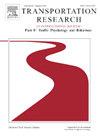Drivers’ use of front crash prevention, lane departure warning and prevention, and speed warning systems
IF 3.5
2区 工程技术
Q1 PSYCHOLOGY, APPLIED
Transportation Research Part F-Traffic Psychology and Behaviour
Pub Date : 2025-02-18
DOI:10.1016/j.trf.2025.01.037
引用次数: 0
Abstract
Introduction
Crash avoidance technologies can aid with the driving task and reduce crashes, but only if used. This study measured use of front crash prevention, lane departure (i.e., lane departure warning or prevention), and speed warning systems (i.e., systems that alert the driver when traveling above the speed limit).
Methods
We observed activation rates of systems that retain their last setting with each ignition cycle on over 2,000 model year 2017 to 2023 vehicles from six manufacturers serviced at branded dealerships in the Washington, DC, metro area in 2023. We analyzed vehicle and driver demographic characteristics to identify factors associated with system use.
Results
Automatic emergency braking was enabled on 93% of vehicles, ranging from 86% to 100% by manufacturer. Lane departure systems were activated on 87% of vehicles, ranging from 56% to 99% by manufacturer. Lane departure system activation rates were higher for systems with prevention capabilities than warning only capabilities and that were activated through a settings menu versus a button. Visual speed warnings were activated on 71% of vehicles, and 14% of vehicles with an audible speed warning had the audible alert on.
Conclusions
Driver use of lane departure systems has improved over time, which may be due to more lane departure prevention systems and design changes that made them more acceptable. Early use of visual speed warning alerts is strong, and we provide manufacturers and engineers suggestions of ways to improve the acceptability of audible speed warning alerts, which are effective at reducing speeding behavior.
驾驶员使用前碰撞预防、车道偏离警告和预防以及速度警告系统
碰撞避免技术可以帮助驾驶任务,减少碰撞,但只有在使用的情况下。这项研究测量了前碰撞预防、车道偏离(即车道偏离警告或预防)和速度警告系统(即超速行驶时警告驾驶员的系统)的使用情况。方法:我们观察了2017年至2023年在华盛顿特区的品牌经销商处维修的六家制造商的2000多辆2017年至2023年车型在每个点火周期中保留上次设置的系统激活率。我们分析了车辆和驾驶员的人口统计学特征,以确定与系统使用相关的因素。结果93%的车辆启用了自动紧急制动,制造商的范围从86%到100%不等。87%的车辆启动了车道偏离系统,各制造商的比例从56%到99%不等。具有预防功能的车道偏离系统的激活率高于仅具有警告功能的系统,并且通过设置菜单而不是按钮激活。71%的车辆启动了视觉速度警告,14%的有声音速度警告的车辆打开了声音警报。随着时间的推移,驾驶员对车道偏离系统的使用有所改善,这可能是由于更多的车道偏离预防系统和设计变化使它们更容易被接受。视觉速度警告的早期使用是强有力的,我们为制造商和工程师提供了提高声音速度警告可接受性的方法建议,这有效地减少了超速行为。
本文章由计算机程序翻译,如有差异,请以英文原文为准。
求助全文
约1分钟内获得全文
求助全文
来源期刊
CiteScore
7.60
自引率
14.60%
发文量
239
审稿时长
71 days
期刊介绍:
Transportation Research Part F: Traffic Psychology and Behaviour focuses on the behavioural and psychological aspects of traffic and transport. The aim of the journal is to enhance theory development, improve the quality of empirical studies and to stimulate the application of research findings in practice. TRF provides a focus and a means of communication for the considerable amount of research activities that are now being carried out in this field. The journal provides a forum for transportation researchers, psychologists, ergonomists, engineers and policy-makers with an interest in traffic and transport psychology.

 求助内容:
求助内容: 应助结果提醒方式:
应助结果提醒方式:


